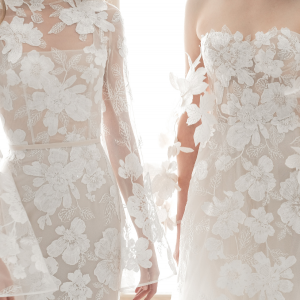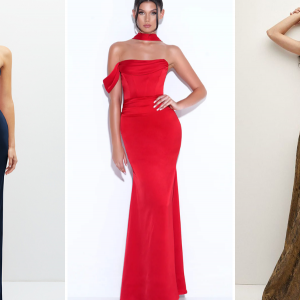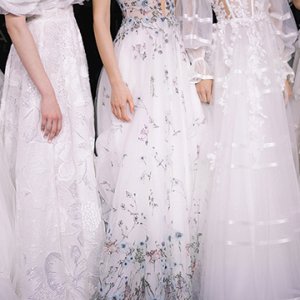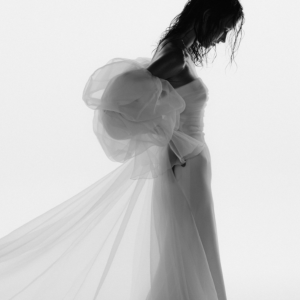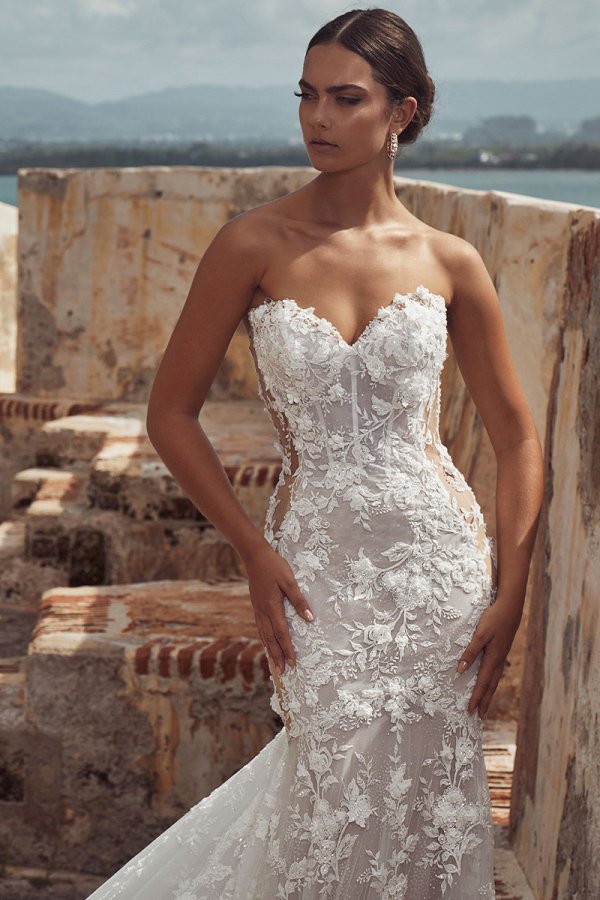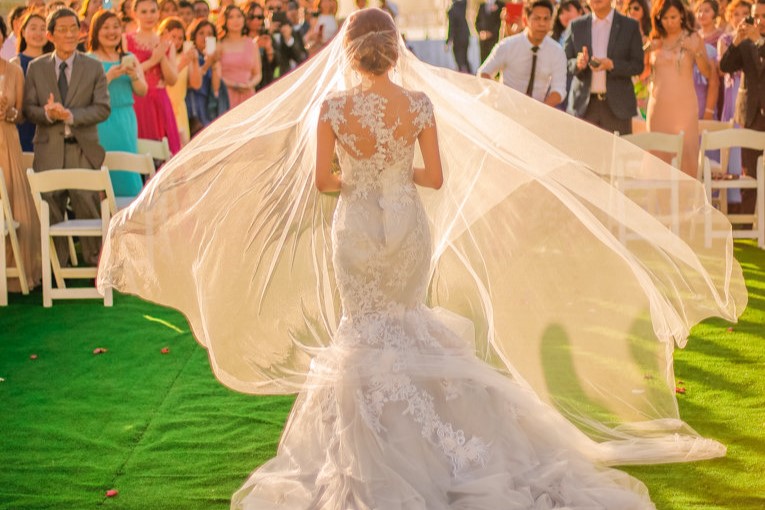
Photo: ProudRad
A - Alterations. "Think of alterations as changes that are made to clothing to ensure that they fit the individual correctly. Taking in your bust to raise the hem, there are many different types of alterations that can be done to your dress to make it fit your body better." —Natalya Kolosok, Manager, New York City Bride
B - Bodice. "This is the top of your gown. It can come in any style, shape, and have all different types of features. Some bodices are daring, featuring a mesh stomach or a cut out. Some gowns are simply two pieces and the top is not connected to the bottom. Some are traditional, some are strapless. Some are simple, and some have a corset back. You can adorn them with anything you like from crystals to beads to lace.” —Leah R. McCoy, President, Wedding Gown Preservation Kit
Bolero. "For brides that want to cover up their arms and shoulders, there are boleros. These are short shrugs or jackets that slip over the shoulders. They'll typically be constructed of fabric that matches the wedding dress." —Kolosok
Bustle. "When a dress is fitted with a long train, it will often have a bustle. This is a buttons or hooks feature that allows the train to be attached seamlessly to the back of the dress to avoid a tripping hazard after the ceremony." —Kolosok
C - Cocktail Attire. "This dress code is meant to be a step above casual, but a step below black tie or black tie optional, but it's notoriously one of the most challenging dress codes for guests to figure out what's appropriate. We'd suggest suits in more informal colors (like a blue or gray shade) and cocktail-length dresses to ensure you're looking just right." —Jason Jackson, COO & President, Generation Tux
Corset. "When a wedding dress has a lace-up closure in the back, it's referred to as a corset. This type of dress feature makes the dress fit better to the individual bride as it allows for optimal adjustment. You've dreamed all of your life about having the perfect wedding. However, when it comes down to planning it, there's a lot involved. Understanding some of the most common vocabulary used can help to make the process much smoother.” —Kolosok
E – Embellishments. "It’s time to get to know the embellishments that will make the most of everything you are wearing. This is the décor. It's like putting sprinkles on ice cream. It's already good, but this can make it better. You can use anything you want as an embellishment if you choose. From fresh flowers to jewelry to beads to lace to everything in between; the sky is the limit and your imagination is your power tool. Using more elaborate embellishment can add a bit of maturity and formality to a gown, but it's certainly not something you are required to do. Embellishment can add a bit of richness to a simple fabric, and it can add just a little bit of elegance to a simple gown. Beads and crystals can also add a bit of color to a traditional gown, which can tie in nicely with other aspects of the wedding." —McCoy
F – Fabrics. "One of the most important aspects of your wedding down is the fabric. Every fabric has a story of its own to tell, and many of them can help make your gown more or less formal. A wonderful example we like to make is that you can take any gown in the world and make the same shape and style in different fabrics, and each one will appear completely different than another. Let's take a mermaid gown for example. By making it out of lace, it's going to appear more romantic and feminine. Using beads rather than lace will make it more pageant-like and bold. Making it out of satin will cause it to fit completely different, and it will take on a more formal look. It's clingier and sometimes sexier. Satin is the most sought-after fabric. It's elegant, expensive, and it's beautiful. It has a language all its own, and many brides want to use this for their own gowns. Chiffon is going to give you a look that’s more whimsical and fun. Organza might be more in the fairytale genre you're looking for, and charmeuse will give you a slightly more mature look. Learn more about how to choose wedding dress fabrics by season." —McCoy
Fit. "There is nothing worse than ill-fit clothing. Remember: your wedding pictures will be around forever. You don't want to be reminded of a bad tuxedo/suit every time you look at your album. Your tailor will be able to tailor a tuxedo/suit that will work perfectly for you." —Vincent Leone, Roma Tailors LLC
Fitting. “A fitting is simply an appointment with a tailor. You'll try on the dress, and they will make a note of any adjustments that need to be made to ensure an optimal fit on your wedding day. Most brides typically have between two and four fittings." —Kolosok
G - Getting Ready Wear. "The term 'getting ready wear' has become increasingly popular in terms of wedding fashion vocabulary in the last five years, and this will only keep growing! This usually is meant to refer to whatever outfit you'll be wearing during your hair and makeup and morning routine the day of the wedding. This includes options like custom sleepwear, satin robes, or even chic sweatsuits! The goal is to ensure you look put together while you’re actually getting put together." —Kristy Breed & Helen Semovski, Director & Designer, Le Rose Stories
Groom. "You are just as important as your beautiful bride! Your wedding day is an important experience and a big step for both the bride and groom. You should look the part! If your bride is willing to go to multiple stores looking for the perfect dress, don’t be so quick to just go to a one-stop shop to rent a tuxedo." —Leone,
H – Hemline. "Long? Short? Calf-length? Floor-length? Ankle length? Mid-thigh? The hemline of your gown is the length of your gown, and you can do anything you want. It might be more 'traditional' to opt for a floor-length hemline, but no one says you cannot opt for a more casual tea-length gown or a flirty, fun, and daring short hemline. You can even do a hemline that’s shorter in the front and longer in the back if that’s what you prefer. The most important thing you should know about your hemline is that it traditionally speaks more to the formality of your wedding than anything else — though it also occasionally speaks to the age of the bride. A gown that reaches the floor implies your wedding is more formal. A shorter gown is a more informal dress, and one that is tea-length might imply that you are having a lovely wedding, but it's not a traditionally formal wedding. Additionally, it might also speak to the number of weddings you've already had. For example, if your mother is getting married to her second husband following the loss of her first, she might decide she would rather wear something tea-length and less formal. The hemline is the part of the wedding dress that sees the most wear and tear on your wedding day, from the photoshoot to the dance floor, and should receive extra care when cleaning your wedding dress." —McCoy
I – Investment. "Custom clothing will cost more than a rental or something from a department store. However, it is an investment in yourself as well as your wardrobe. Custom clothing lasts decades and will be a piece you will always cherish. By customizing your wedding day tuxedo or suit, you will have a keepsake to look back on and remember your special day." —Leone
K - Keyhole. "When it comes to lace illusion and high-neck wedding dresses, they typically both sport a keyhole. This is a small tear-shaped or circular opening at the back of the dress." —Kolosok
L - Lace Illusion. "When you're looking to have a dress with lace that seems to cling perfectly to your body, you'll likely use a lace illusion. This is when a skin-colored mesh is used in compound with lace to provide an illusion of less coverage of the body." —Kolosok
Lapels. "Not all lapels (or tuxedos) are the same. At Generation Tux, we offer lapel options in three different styles: shawl, peak, or notch. The shawl lapel has a continuous round edge, making it a classic choice with a modern twist. The peak lapel is another formal option, where the lapel points upward at the seam. If you're having trouble deciding which style to choose, we'd suggest the notch lapel: a classic style that works well for essentially any dress code." —Jackson
N – Neckline. "Ladies, your decolletage is one of the most flattering parts of your body, so you obviously want a beautiful neckline on your gown. There are two specific reasons this is so important. First and foremost, this is the one area of the dress that either makes or breaks your overall look. It's where everyone looks first, since it is the closest portion of fabric to your face. If your neckline is not flattering on your body, you won't find that your gown accentuates your face as well as it should. The second reason is basically the same in that it's the first part of the dress that people notice. Some necklines are high and leave much to the imagination. Those are called jewel, bateau, and mandarin. They don't show much skin. They sit high on your neck and they are full-coverage, which makes these necklines perfect for a more conservative bride. Sweetheart, halter, portrait, one-shoulder, and strapless gowns leave a lot more skin visible to the public. These are wonderful necklines for brides who have beautiful shoulders, long necks, lovely collarbones, or who simple want to show off a stunning necklace." —McCoy
P - Personal Style. "When working with a bespoke tailor, you will be able to go over every detail of your garment. This is a partnership between you and your tailor. Make sure to talk about buttons, linings, stitches, and fabrics. This is your time to show your sense of style in designing and showing your creative side." —Leone
Q – Quality. "We use the finest quality fabrics directly from Italy, England, and Australia We produce all our garments domestically and by hand. We have a very old-skill approach to what we do. We are 3rd generation tailors. What we do is a precise craft and will guarantee to be noticed." —Leone
S – Silhouette. "We like to call this the shape of your gown to make things simple. This is probably — at least for most brides — the most important part of the gown as a whole. This is the overall style, and it's what makes a major decision for most brides. A princess bride is going to want a full bell-shaped gown. A bride who wants something softer or more romantic — or simply more forgiving — might choose an empire waist gown. A mermaid gown is typically sexier and more fun. A sheath is so elegant and classic. The silhouette of the gown can speak to your specific style as well as the season and the type of wedding you are having." —McCoy
Skirt. "The skirt is part of the gown, and it’s part of so many other features in the anatomy department, but you can do a lot with a skirt outside of the just the waistline and the hemline and the fabric and the embellishments and the color. For example, you can bustle your skirt. This means you can have a train attached to your gown that adds a dramatic flair while you walk down the aisle. When you’re done with that, you can pin it, button it, or attach it with another means, to the back of your skirt. This is called a bustle, and it adds so much depth and interest to your gown. You can add a pleat. You can add a slit. You can add a flounce, or a drape, or you can add layers. Anything you want to add to a skirt can change the game completely. It can take a simple gown and add flair and dramatics, elegance, or a little bit of sex appeal. It's all about what you want and who you are as a bride." —McCoy
Sleeves. "Most brides choose sleeves based on the season, and we have no problem with that. A gown with long sleeves it not typically the most desired sleeve in the middle of a summer wedding on the beach. However, you can wear whatever you want. Just know that many brides choose a sleeve that accentuates the tone of the wedding and the skirt of the dress. Long sleeves, cap sleeves, 3/4 length sleeves, sleeveless, short sleeve, one sleeve, fitted sleeves, bell sleeve, and everything in between. You can even find removeable sleeves if you want to go that route. The other reason sleeves are so important is that they allow you to decide how conservative you want to be on your big day. Some brides want a very daring neckline and short sleeve or no sleeve during their reception in a fun reception venue, but they need something with a lot more coverage in a conservative ceremony venue (i.e. a religious location like a church). You can also purchase sleeves in the form of a fitted jacket or top that go on over the dress so you look more conservative when necessary, but you can take it off and show off your gorgeous gown when that part of the wedding is over." —McCoy
T – Train. "Do you have a train, do you not have a train, or do you have a removable train? There are so many different feelings about trains, and no one is wrong. This is a transformative piece, and you can change it if you want. You can open it up and allow it to trail behind you and add a beautiful interest to your gown as you walk down the aisle, and you can often hook it to the back of your dress in a way that is beautiful and decorative when you are ready to start dancing. The length of your train might indicate the formality of the wedding. The longer the train, the more formal the wedding, so to speak. These are chapel and cathedral length trains, and they are traditionally reserved for very formal religious ceremonies. They can be bustled afterward for easy movement. A Watteau or court train is one that starts at the shoulders. It’s almost waterfall-like. They're not super formal. However, a detachable train is one that's easily removed following the wedding, and it is one that is very easy to call informal. Keep in mind that having a long train or detachable train can greatly impact the cost of your wedding dress." —McCoy
W – Waistline. "It's the part of the dress where the skirt meets the top. Its design, additionally, helps bring a shape to the gown. It can become a signature style, it can become a simple style, or it can create something more traditional. A basque waistline, for instance, can help add more appeal to a princess-like fairytale ball gown. An A-line gown comes with a more natural waistline that's feminine, simple, and elegant. If you want to make it seem like you have a longer torso, you can go for a dropped waist. If you're looking to appear thinner, you may choose an empire waist gown. This is also a popular style for those who might be expecting during their wedding." —McCoy

